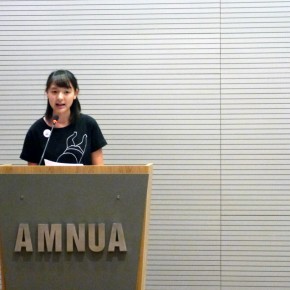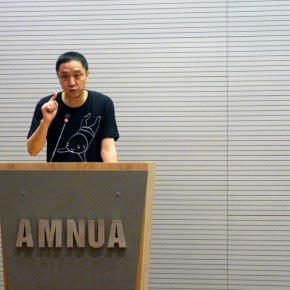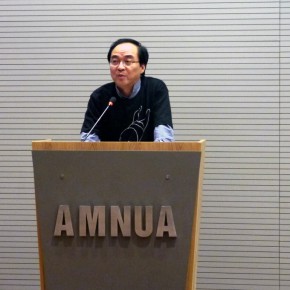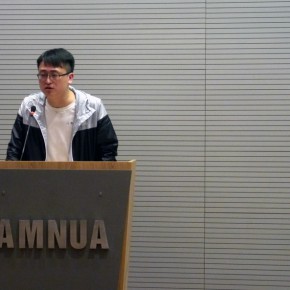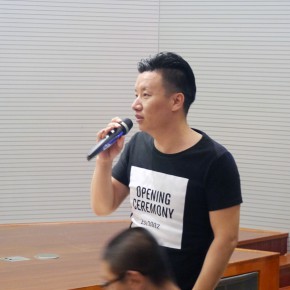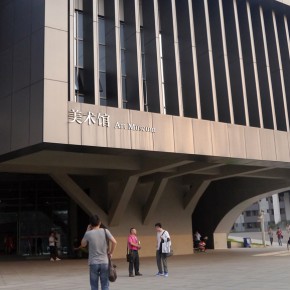
At 2:00 pm on September 26, the press conference and documentary premiere were held in the Multi-functional Hall of AMNUA, Zhang Chengzhi, vice President of Nanjing University of the Arts, Li Xiaoshan, Director of AMNUA, and other honoured guests as well as the artists and more than 20 people from the media watched the documentary, and praised the shooting skill and production level of the documentary, and highly applauded the positive persistent artistic spirit of the investigative artists. Vice President Zhang Chengzhi fully affirmed the academic significance of “Polyphony” in his speech, and he believed that it didn’t only reveal AMNUA’s focus on social problems, determination in restoring ecology, and also revealing that the AMNUA review and it's role in running a school along with it's artistic mission. Li Xiaoshan counselled the young artists as they shouldn’t become two kinds of artists, the first kind of artists focus on the history of art, attempting to become another “Van Gogh”, sighing for the ignorance of the public, which was just an excuse for an escape; the second kind of artists are realistic artists, because there is too much fame and fortune in reality, which will digest the sincere nature of art. Li Xiaoshan believed that the artists should face themselves, taking art as a content of life.
In addition to the long documentary “Polyphony ? Beijing”, the exhibition presents more than 50 works by 16 artists (art groups), including Cheng Chen, Hu Qingtai, Hu Guoqing, Jiang Huajun, Leng Guangmin, Li Bingyuan, Liang Ban, Lu Lei, Irrelevant Commission, Xin Yunpeng, Xiong Huang Group, Balcony Collective, Yang Junling, Yu Jidong, Zhang Ruo, Zhang Xiangxi. The Young, non-institutional, artistic ideal is a common featureof these artists, although their creative condition is not good, they still insist on the pursuit of their art ideals in the artistic way of painting, sculpture, video, installation, or performance. Li Xiaoshan also said that the exhibition is “remarkable”, for example, when entering the exhibition hall, you would be attracted by a platform looking like a machine tool, which is an installation entitled“Irrelevant to Art Factory” by Irrelevant Commission, while seven groups of sculptural mud were evenly arranged on the rotating table, members of Irrelevant Commission stood around the rotating table, every one threw mud in a fixed action, and ultimately formed a sculpture. It mimicked the assembly line in a processing factory, and contemporary art is like a “processing factory”, it was necessary for artists to constantly code their works in order to continue the production, and prove the value of existence.
A good exhibition throws a question to society, and faces and solves it in practice. The “Polyphony” exhibition is created through a focus on the key words “success, ideal, position and value” which questions society. This time “Polyphony ? Beijing” question is that: “If you are successful, are you an artist?” For this way in preparing an exhibition, curator Wang Lin signed with emotion and said that the art exhibition became a kind of consumption in such an efficient society, when the audiences visited an exhibition, they mainly saw the work, rarely thinking about what thought did the exhibition bring, so he wanted to create some “paranoid” exhibitions, to discover the social meaning behind it. Lin Shuchuan is the initiator and main curator of the “Polyphony” exhibition, he hoped this project can become a label for AMNUA, of course, there is still a long way to go, but he also smiled and said, he didn’t fight in isolation.
The exhibition is the second station of the “Polyphony” project, and the project will continue, curator Lin Shuchuan also revealed that after the end of the whole exhibition, it will practice a summary activity, on the one hand, it is an overview of the national ecology of art, on the other hand it is also a review of all previous activities, to make “Polyphony” become a dynamic investigation.
“Polyphony –Chinese Art Ecological Investigation” is a key academic program dominated and planned by the Art Museum of Nanjing University of the Arts (AMNUA), with an in-depth research and truly presentable display of the non-institutional artists from across the country in the form of a field investigation on5 year basis, aimed at restoring the integrated Chinese art ecological appearance, and through this lead to notable social issues. In addition to a conventional exhibition of work, the exhibition is in cooperation with a long documentary film. The first step of the series exhibition - “Polyphony I” - Chinese Art Ecological Investigation ? Jiangsu, Zhejiang, Shanghai and the exhibition documentary film was finished in 2013.
For “Polyphony II” Beijing, the curatorial team and documentary team of AMNUA spent 7 months on the long-term project in Beijing with the on-site investment of the major artists’ settlements (Songzhuang, Caochangdi, No.1 Art District, Feijiacun, Heiqiao, Huantie, Luoma Lake) and important art venues, spaces which aimsto record the art ecology in Beijing and the real state of life and creation of the participating artists. It ultimately determines the 16 participating artists, including 3 art groups. The exhibiting artists bring their latest creation to the audience, including easel painting, performance, video, installation, sculpture, and other artistic categories.
The curator of AMNUA, initiator of the project Lin Shuchuan serves as the curator of the exhibition, in cooperation with an independent Beijing curator Wang Lin who is invited to serve as the co-curator who plans and implements the project. Xiao Qiancao, director of the “Daytime Fireworks” documentary continues to be the general director of “Polyphony” series of documentaries in the documentary unit. The exhibition is unfolded through the key words “success, ideal, position, value”. Questioning Chinese artistic ecology again: If there’s a lack of a standard like “the science of success”, will you still do art?
It started to have a preliminary investigation in Beijing ecology and artists from September 2013, and formally started to shot the documentary on April 1. In the process of preparation it accumulated nearly 200,000 words of text and 200 hours of video documentary, which is on show in a concentrated way from September 26, 2014.
The exhibition will continue to October 14.
About the exhibition
Duration: September 26 - October 24, 2014
Venue: Hall 3 of Art Museum of Nanjing University of the Arts (AMNUA)
Premiere of Documentary Film: 14:00, on September 26, 2014
Venue of Documentary Film: Multi-functional hall of Art Museum of Nanjing University of the Arts (AMNUA)
Art director: Li Xiaoshan
Curator: Lin Shuchuan
Co-curator: Wang Lin
Participating Artists: Cheng Chen, Hu Qingtai, Hu Guoqing, Jiang Huajun, Leng Guangmin, Li Bingyuan, Liang Ban, Lu Lei, Irrelevant Commission, Xin Yunpeng, Xiong Huang Group, Balcony Collective, Yang Junling, Yu Jidong, Zhang Ruo, Zhang Xiangxi
Planning Team: Qu Jun, Chen Rui, Gao Ya, Li Li
Director of Exhibition: Mao Chunhai
Director of Media: Xu Yue
Director of Public Education: Xuan Wenling
Documentary Filmmaker: Xiao Qiancao
Documentary Team: Zhang Xiaolong, Zhang Meng, Ouyang Wen, Song Xiaoyue, Wang Lexing, Liu Yingkai, Hou Zhengtong, Xiong Wenkai, Wang Chao, Li Mingze
Text and photo by Zhang Wenzhi/CAFA ART INFO
Translated by Chen Peihua and edited by Sue/CAFA ART INFO


